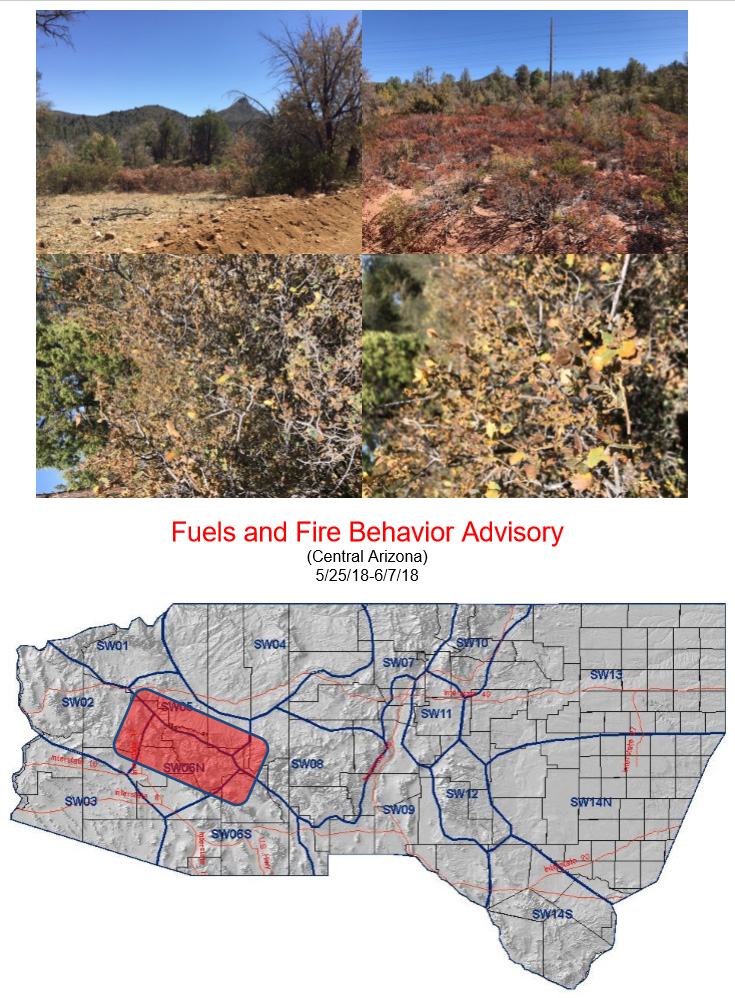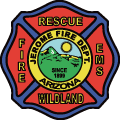Courtesy of: https://www.predictiveservices.nifc.gov/
Fuels and Fire Behavior Advisory Central Arizona May 25th 2018
Subject:
A persistent 6-9 month drought across Arizona has dropped fuel moistures to critically low levels in both the brush fuels types and live foliar fuels. These critically low fuel moistures increase available fuel loading, which contributes to and supports an above normal potential for extreme fire behavior in both brush fuel types and timber fuels – with or without critical fire weather conditions. Discussion: The less than one year, but potent, drought has reduced the fuel moisture in brush fuel types across all of central Arizona.
Difference from normal conditions:
Drought creates more available fuel in brush fuel types which will increase fire intensities, crown fire potential and difficulty of control for fire suppression resources. Live fuel moisture content within chaparral species this year is at a record low across much of the central highlands and mid-elevations below the Mogollon Rim in Arizona. Short duration rain events provide only short-term fuel moisture improvement in timber litter fuels (1, 10, and 100 hour dead fuels). Fuels rebound quickly to previous dryness levels. Short duration rain events provide no fuel moisture recovery in large dead and live foliar fuels.
Concerns to Firefighters and the Public:
• Typical chaparral fire behavior relies on 3 factors for alignment to create elevated fire behavior: 1. Wind, 2. Slope, 3. High Temperatures. Typically, once one or more of the 3 factors falls out of alignment, chaparral tends to “shut off.”
• Live fuels conditions this year are extreme enough that a lack of alignment of wind, slope, and high temperatures won’t likely matter: Fire behavior in chaparral this year will likely move freely and with extreme fire behavior with only one of the three factors.
• This year is not likely to be typical in chaparral as many chaparral species are shedding leaves and are exhibiting stress due to drought.
• Chaparral this year is likely to exhibit robust fire behavior at night despite cooler temperatures and RH recoveries.
• Where chaparral occurs with needle drape as an understory, fire behavior will support torching and crown fires within pine stands.
• Observed fire behavior on recent fires has shown higher resistance to control, rapid rates of spread, and very active fire behavior, even with moderated temperature and humidity values Mitigation Measures:
• Local briefings need to be thorough and highlight specific fire environment conditions. These include but are not limited to local weather forecasts, Pocket Cards, ERC’s, live and dead fuel moistures, and special fuel conditions such as drought and insect mortality
• Lookouts, both on the ground and in the air, can help identify the initiation and location of crown fire. They can also provide the location of resultant spot fires from active crown fire.
• Firefighters should acknowledge that fire growth and fire behavior they encounter this year may exceed anything they have experienced before due to the drought factor. Normal strategies and tactics may need to be adjusted to account for the drought factor.
Area of Concern:
For more information, maps, etc: https://www.predictiveservices.nifc.gov/fuels_fire-danger/fuels_fire-danger.htm
The brush fuels within this area of concern are the target for this fire behavior advisory.





